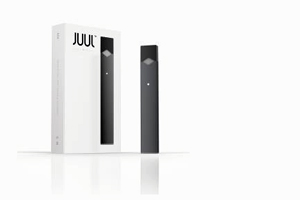At the Global Forum on Nicotine in Warsaw, Juul Labs today presented the results of two studies—one showing a significant difference in exhaled toxicants between vapor products and combustible cigarettes, and another showing that smokers who used nontobacco-flavored Juul products were more likely to switch from cigarettes than those who used tobacco-flavored Juul products.
The first clinical study found an approximately 99 percent reduction of formaldehyde and carbon monoxide particles in secondhand (exhaled breath) vapor associated with the use of the Juul system compared to use of combustible cigarettes. The aggregate measurements of formaldehyde and carbon monoxide particles were not statistically different from the background levels measured without product use.
This study set out to evaluate the contents and quantity of the exhaled breath and emissions profiles of secondhand vapor of the Juul system and another vapor device against that from combustible cigarettes.
Thirty adult smokers, who reported smoking a minimum of 10 combustible cigarettes per day, were recruited for this study. They were divided into three groups of 10 and assigned to three different environments designed to simulate residential, office and hospitality environments. Each group used one product for a four-hour session in each of the three different simulated settings. Air quality was assessed at baseline and after each four-hour session in which subjects partook of each product as much as desired. Exhaled breath was collected into a dedicated device after each of 10 prescribed puffs. Results were evaluated against sham, or dummy, devices, and were reported for chemical levels in individual exhaled breath and general room air quality.
Data from the individual exhaled breath analysis show that levels of formaldehyde and carbon monoxide were reduced approximately 99 percent or more with the Juul system compared with combustible cigarettes. The use of vapor products resulted in elevated levels of propylene glycol across environments compared to cigarettes. Propylene glycol is a major component of the e-liquid. Emissions from the Juul device cleared more quickly than with the comparator device.
In air quality analyses, concentrations of respirable particles were elevated in every environment and product evaluated. However, the average rise in airborne particles was lower with the Juul system versus the other vapor product and combustible cigarettes. Room air nicotine levels were 89 percent–95 percent lower following ad libitum vapor product use versus cigarettes. The study authors note the presence and variability of background environmental source chemicals as a factor in the analysis.
“These findings align with the current scientific understanding of the role alternative nicotine delivery systems can play in the potential harm reduction for adult smokers and the corresponding environmental impact for nonsmokers for the good of public health,” said Josh Vose, vice president, medical and clinical affairs at Juul Labs.
The second study conducted by Juul Labs found that adult smokers who primarily used non-tobacco-flavored Juul products were more likely than those who primarily used tobacco-flavored Juul products to have successfully switched from smoking combustible cigarettes over a six-month period.
The study followed more than 37,000 U.S. adult smokers who had recently purchased Juul products at retail or on the company’s e-commerce platform. Participants completed online surveys over six months.
“There has been an active discussion about the role of flavors in supporting adult smokers who want to switch from combustible cigarettes, and at Juul Labs we are committed to driving research to inform these discussions,” said Erik M. Augustson, senior director of behavioral research and interventions at Juul Labs.
“We wanted to assess how flavor preference at various time points—30-days, 60-days and 90-days after initiating Juul use—is associated with the likelihood of smoking abstinence in the future. For example, how does a person’s flavor preference at 60 days impact their likelihood to be vaping rather than smoking at 90 days? These results show that, for the study cohort, use of Juul products in non-tobacco flavors was associated with higher switching rates compared to those who used Juul products in tobacco flavors.”
The study, “Flavored Juul Use and Smoking Abstention Among Adult Smokers,” analyzed data from a subset of 21,332 smokers aged 21+ years who had purchased a Juul starter kit and completed at least two follow-up assessments. Study participants completed baseline and 30-day, 60-day, 90-day and 180-day follow-up assessments via online surveys. The assessments asked study participants about Juul flavor use and switching—defined as no smoking, not a single puff, for the previous 30 days prior to the assessment.
The study was designed to assess what flavors were being used and how the use of flavors was associated with smoking behavior over time: that is, the likelihood of abstaining from smoking and switching to vaping at the next follow-up survey. Juul Labs commissioned and funded the study, the Centre for Substance Use Research (CSUR) independently designed and administered the survey underlying this data analysis.
Across 30-, 60- and 90-day assessments, use of mint/menthol and non-tobacco/menthol-based (NTM) flavors, compared with the use of tobacco flavors, were positively associated with past 30- day smoking abstinence at the 60-, 90- and 180-day assessments. Adult smokers who primarily used mint/menthol and NTM flavors were 14 percent and 7 percent more likely, respectively, to have switched than those primarily using tobacco flavors across the 6-month study period.
“These results add to a growing body of evidence that suggest that use of vapor products in non- tobacco flavors may potentially help adult smokers switch from cigarettes,” Augustson said.

